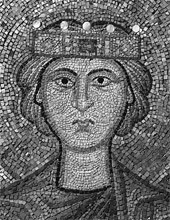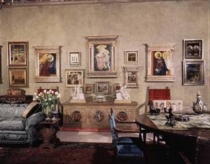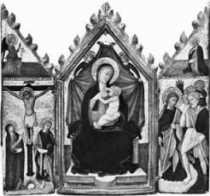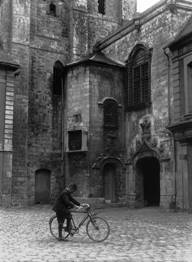The National Gallery of Art photographic archives and Dumbarton Oaks Research Library and Collection cosponsored Professor Otto Demus’s campaign from 1975 to 1979 to photograph the mosaic art in Venice’s Basilica of Saint Mark. Ekkehard Ritter was the photographer, and the project culminated in Demus’s seminal book, The Mosaics of San Marco in Venice (1984). Dumbarton Oaks is the repository for the color photography; the black-and-white negatives are held by the Gallery’s department of image collections. Nearly 1,200 digital scans are available online.
Digital Projects
San Marco Mosaics

Saint Basilissa, mosaic,
Basilica of San Marco, Venice.
Kress Collection of Historic Images

Samuel H. Kress’s New York City apartment, Venetian sitting room, 1938/1940
The Kress Collection of Historic Images at the National Gallery of Art—more than 18,300 scans of paintings, drawings, sculptures, and decorative arts purchased or once considered for purchase by Samuel H. Kress and the foundation he established in 1929—has been digitized, making these significant holdings more accessible to researchers around the world through the Gallery’s department of image collections. Kress donated most of these objects to 90 museums, colleges, and other institutions in 33 states, with the greater number of these gifts coming to the National Gallery of Art.
The digital files were made from two sources. The first is a group of negatives, photographs, and lantern slides, largely gifts from the Samuel H. Kress Foundation, that range in date from around 1910 to 1969; the second, a group of negatives made of the National Gallery of Art Kress objects by staff in the department of imaging and digital services from around 1942 to around 2007.
Both groups of images document works of art in various states of conservation, as well as some x-ray, infrared, and ultraviolet images. In a few cases, the files include scans of comments by scholars written on the backs of the photographs. Photographs of Samuel Kress’s apartment in New York (above) show 282 magnificent objects—including the Madonna and Child by Domenico Veneziano and Masolino’s Gabriel and the Virgin Annunciate—as they were arranged before their dispersal.
Art historians, conservators, and students have used these images to enhance their understanding of these objects. The photographs can illuminate aspects of the works of art that we can no longer see. For instance, conservators routinely study these images in order to anticipate remnants of earlier damage or restorations. Art historians may compare high resolution details to other known works by an artist to assist in attribution questions. Students may better understand the “life” of a work of art by seeing changes over time, illustrated through a variety of reproductive processes.
The Kress Collection of Historic Images project was made possible by two generous grants by the Samuel H. Kress Foundation. Learn more about the project.
Foto Reali Archive

Unknown artist (Bologna), 15th century,
Madonna and Child Enthroned
with Angels, location unknown.
The Foto Reali Archive is a resource prized by scholars, and as such it is routinely consulted by art historians, conservators, curators, and other researchers. Foto Reali was a Florentine photographic firm that surveyed private art collections as well as dealer inventories in Italy in the early twentieth century, often photographing the paintings in situ. Among the private collections represented in the archive are such key collections as those assembled by Harold Acton, Vittorio Cini, Alessandro Contini-Bonacossi, Luigi Grassi, and Eugenio Ventura. More about Foto Reali Archive.
Clarence Ward Archive

Hotel de Ville, Abbeville,
France, destroyed 1940.
Clarence Ward Collection,
Arthur E. Princehorn, photographer.
The Clarence Ward Archive focuses on French medieval and American architecture and consists of more than four thousand large-format nitrate negatives, from which three thousand black-and-white photographs and four thousand digital images have been produced. These negatives were the product of photographic campaigns undertaken by Clarence Ward (1884–1973) during the 1920s and 1930s, with the assistance of Arthur Princehorn (1904–2001), staff photographer at Oberlin College. Ward was a distinguished professor of art history at Oberlin College, as well as the founder of the college's art library and the first director of the campus museum, the Allen Memorial Art Museum. Since Ward conducted his French photographic campaigns during the early part of the 20th century, the resulting photographs provide vital documentation of many structures that were subsequently damaged during World War II.
The Foto Reali and Clarence Ward digitization projects were a collaboration between the National Gallery of Art and ARTstor (a nonprofit initiative founded by The Andrew W. Mellon Foundation) to make these important scholarly resources more broadly available for noncommercial, scholarly, and educational purposes through the use of digital technologies.
Individual object records for these collections can be found in the library's online catalog.
The library is open Monday through Friday 11:00 a.m. to 4:30 p.m. We are closed Saturday, Sunday, and federal holidays.
To help us prepare materials ahead of your initial visit, we recommend you request an appointment.
Location
National Gallery of Art East Building
4th Street and Pennsylvania Avenue NW
Washington, DC
Mailing Address
Image Collections
National Gallery of Art
2000 South Club Drive
Landover, MD 20785
Contact [email protected] or call (202) 842-6026
Travels Across Russia: Oranienbaum
In Situ: Henry Moore, David Finn, and the Experience of Location
Verrocchio, Connoisseurship, and the Photographs of Clarence Kennedy
Before the Fire: Notre-Dame de Paris in Pictures
Travels Across Russia: Avant-Garde Architecture in Moscow
John Brampton Philpot and Photography in 19th-Century Florence
Beauty, Fire, & Memory: Lost Art of the Kaiser-Friedrich-Museum
Process and Participation in the Work of Christo and Jeanne-Claude
Revelations from Reproductions:
Fifteenth-century Italian Paintings in the National Gallery of Art
The Solemnity of Shadows: Juan Laurent’s Vision of Spain
Patrimony in Peril: Germany’s Survey of Mural Paintings Threatened During World War II
War Damage in Baden and Württemberg: Monuments Men Albums
Travels across Russia: Ekaterinburg
Travels Across Russia: Torzhok
United States Centennial International Exhibition
Philadelphia - 1876